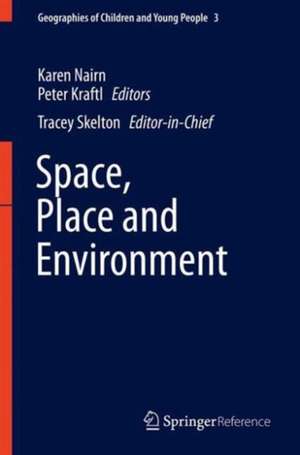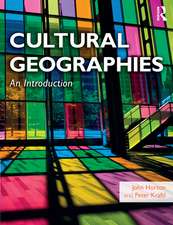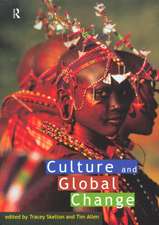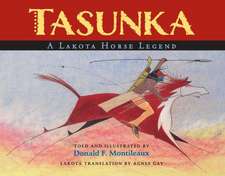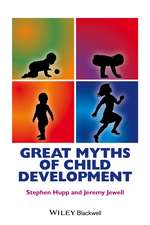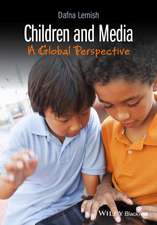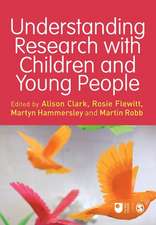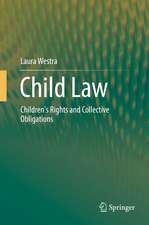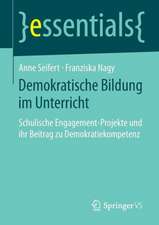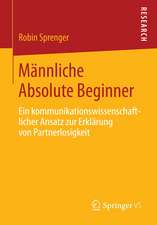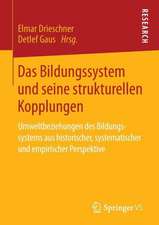Space, Place, and Environment: Geographies of Children and Young People, cartea 3
Editat de Karen Nairn, Peter Kraftl Tracey Skeltonen Limba Engleză Hardback – 6 iul 2016
The volume is organised into five sections: Indigenous Youth: Space and Place; Children, Nature and Environmental Education; Urban Spaces; Home/less Spaces; and Border Spaces. These themes signal the major issues in cutting-edge children’s geographies scholarship. Diverse geographical contexts are covered in this volume – including Australia, Brazil, Canada, Cyprus, Ecuador, India, Indonesia, Kazakhstan, Mexico, Morocco, New Zealand, Peru, Slovenia, Spain, the United Kingdom and the United States.
All of the contributors advocate greater recognition of children and young people’s spatial rights, whether in the home, outdoors, at school, crossing borders, in public and digital spaces, or simply looking for a safe place to sleep. Children and young people’s perspectives on space, place and the environment, and their desire for places to call their own, tie the volume together. The volume is a testament to the politics of the spaces and places of childhood, highlighting how many children and young people face obstacles to living well and to living where they desire.
Preț: 2117.76 lei
Preț vechi: 2582.63 lei
-18% Nou
Puncte Express: 3177
Preț estimativ în valută:
405.22€ • 424.23$ • 335.30£
405.22€ • 424.23$ • 335.30£
Carte disponibilă
Livrare economică 17-31 martie
Preluare comenzi: 021 569.72.76
Specificații
ISBN-13: 9789812870438
ISBN-10: 9812870431
Pagini: 500
Ilustrații: XXIII, 566 p. 44 illus., 41 illus. in color.
Dimensiuni: 155 x 235 x 36 mm
Greutate: 1.27 kg
Ediția:1st ed. 2016
Editura: Springer Nature Singapore
Colecția Springer
Seria Geographies of Children and Young People
Locul publicării:Singapore, Singapore
ISBN-10: 9812870431
Pagini: 500
Ilustrații: XXIII, 566 p. 44 illus., 41 illus. in color.
Dimensiuni: 155 x 235 x 36 mm
Greutate: 1.27 kg
Ediția:1st ed. 2016
Editura: Springer Nature Singapore
Colecția Springer
Seria Geographies of Children and Young People
Locul publicării:Singapore, Singapore
Public țintă
ResearchCuprins
1. Can School Gardens Deepen Children’s Connection to Nature?- 2. Engaging Young People in Climate Change and Sustainability Trails: Local Geographies for Global Insights.- 3. Play and Learning Outdoors: Engaging with the Natural World using Forest School in the UK.- 4. Posthumanist Approaches to Children's Environmental Education: Theorizing Human-Animal Relations.- 5. Youth Discourses of Sustainability in Denpasar, Bali.- 6. Active Urban Children.- 7. Parkour, Activism and Young People.-8. Rangatahi Maori and Identity in Facebook.- 9. The Role of Affect and Emotion in Children’s Place-making.- 10. A Review of Research on Bedroom Culture.- 11. Geographies of Sleep Among Brazilian Street Youth.- 12. New Spaces, Blurred Boundaries, and Embodied Performances on Facebook.- 13. The Bedroom: A Missing Space within Geographies of Children and Young People.- 14. Border Spaces: Geographies of Youth Exclusion, Inclusion and Liminality.- 15. Children and Youth at the Border: Agency, Identityand Belonging.- 16. Children's Rights and Mobility at the Border.- 17. Young People’s Rights to Recreate Spaces and Reimagine Borders.- 18. Children's Neighbourhoods: Places of Play or Spaces of Fear?- 19. Living in the Majority World: Children and Young People in Changing Urban Environments.- 20. Physical and Virtual Public Spaces for Youth: The Importance of Claiming Spaces in Lima, Peru.- 21. Rural Youth: Mobilities, Marginalities and Negotiations.- 22. Teenagers' Sense of Neighborhood in Barcelona.- 23. The Role of Common Spaces in the Lives of Children Living in Urban Poor Settlements in India.- 24. Young People's Representations of Urban Space.- 25. Geographies of Indigenous Children and Youth: A Critical Review Grounded in Spaces of the Colonial Nation State.- 26. Global Cities and Young People: Teenagers’ Citizenship in Singapore.- 27. Maori Young People, Nationhood and Land.- 28. Slipping as a Socio-spatial Negotiation: Teenagers and Risky Landscapes.
Recenzii
Notă biografică
Associate Professor Karen Nairn is currently based at the Otago University College of Education, Dunedin, New Zealand. Her current research focuses on youth identities and post-school transitions. Her recent book Children of Rogernomics. A neoliberal generation leaves school, connects the stories of young people with the wider social and economic story of New Zealand during the last three decades. More broadly, her research focuses on processes of exclusion in education shaped by gender, sexuality and race. Her research portfolio is interdisciplinary in nature with contributions to education, youth studies, geography, and qualitative research. Prior to her university career, she was a high school geography teacher.
Her future research plans revolve around investigating how diverse collectives of young people think about a future threatened by climate change, economic precarity, and political instability. Her new research intends to find out what young people consider the most urgent issues to address, how hope influences their collective actions for change, and how their identities are shaped in the process.
Tracey Skelton is Associate Professor of Human Geography in the Department of Geography at the National University of Singapore. She was previously Professor of Critical Geographies at the University of Loughborough in the UK. The essential elements of her research career focus on people who are socially, politically, and intellectually excluded. Her early work focused on the Caribbean and issues of gender and racial inequality, feminist geographies, and methodological analysis. She has contributed to culture and development debates, particularly through her longitudinal research on the island of Montserrat. Recently, A/P Skelton returned to this field of scholarship through research with volunteers and host organizations in Cambodia as part of a major comparative and collaborative project on development partnerships. She was the principal investigator of a major comparative urbanism research project on the livability, sustainability, and diversity of four Asian cities: Busan in South Korea, Hyderabad in India, Kunming in China, and Singapore.
A/P Skelton is a recognized international leader in the subdiscipline of children’s and young people’s geographies. In particular, her work has served to challenge the invisibility and marginalization of young people from geographic academic research at the same time as it has demonstrated the rich and varied ways in which young people live their lives both spatially and temporally alongside, but differently from, adults. Her research work has been funded by key research institutions such as the Economic and Social Research Council and the Arts and Humanities Research Council of the UK; the Faculty of Arts and Social Science Academic Research Fund and the Global Asia Institute, both of the National University of Singapore; the Australian Research Council; and the Social Science and Humanities Research Council of Canada.
A/P Skelton was a founding editorial board member of the international journal Children’s Geographies and has been the Viewpoints Editor since 2005 and became the Commissioning Editor for Asia in 2010. She is on the editorial boards of the following journals: Geoforum, the Singapore Journal of Tropical Geography, Geography Compass, and ACME: International Journal of Critical Geographies (open access). She has coauthored 2 books, edited 3 collections, guest-edited 2 special journal issues, and published more than 70 journal articles and chapters. She is a passionate teacher and graduate supervisor. She is committed to the politics of research dissemination in accessible formats, in particular to enable the participants in her research projects to understand and recognize their coproduction of knowledge whether through specialized small-scale workshops, translation of reportsinto local languages, or production of audiovisual materials.
Her future research plans revolve around investigating how diverse collectives of young people think about a future threatened by climate change, economic precarity, and political instability. Her new research intends to find out what young people consider the most urgent issues to address, how hope influences their collective actions for change, and how their identities are shaped in the process.
Tracey Skelton is Associate Professor of Human Geography in the Department of Geography at the National University of Singapore. She was previously Professor of Critical Geographies at the University of Loughborough in the UK. The essential elements of her research career focus on people who are socially, politically, and intellectually excluded. Her early work focused on the Caribbean and issues of gender and racial inequality, feminist geographies, and methodological analysis. She has contributed to culture and development debates, particularly through her longitudinal research on the island of Montserrat. Recently, A/P Skelton returned to this field of scholarship through research with volunteers and host organizations in Cambodia as part of a major comparative and collaborative project on development partnerships. She was the principal investigator of a major comparative urbanism research project on the livability, sustainability, and diversity of four Asian cities: Busan in South Korea, Hyderabad in India, Kunming in China, and Singapore.
A/P Skelton is a recognized international leader in the subdiscipline of children’s and young people’s geographies. In particular, her work has served to challenge the invisibility and marginalization of young people from geographic academic research at the same time as it has demonstrated the rich and varied ways in which young people live their lives both spatially and temporally alongside, but differently from, adults. Her research work has been funded by key research institutions such as the Economic and Social Research Council and the Arts and Humanities Research Council of the UK; the Faculty of Arts and Social Science Academic Research Fund and the Global Asia Institute, both of the National University of Singapore; the Australian Research Council; and the Social Science and Humanities Research Council of Canada.
A/P Skelton was a founding editorial board member of the international journal Children’s Geographies and has been the Viewpoints Editor since 2005 and became the Commissioning Editor for Asia in 2010. She is on the editorial boards of the following journals: Geoforum, the Singapore Journal of Tropical Geography, Geography Compass, and ACME: International Journal of Critical Geographies (open access). She has coauthored 2 books, edited 3 collections, guest-edited 2 special journal issues, and published more than 70 journal articles and chapters. She is a passionate teacher and graduate supervisor. She is committed to the politics of research dissemination in accessible formats, in particular to enable the participants in her research projects to understand and recognize their coproduction of knowledge whether through specialized small-scale workshops, translation of reportsinto local languages, or production of audiovisual materials.
Textul de pe ultima copertă
This volume demonstrates the multiple ways that space, place and environment interact with children and young people’s lives. The contributors offer a suite of cutting-edge tools and lively examples for theorising how space, place and environment are (con)figured in children and young people’s lives. They demonstrate how the social borders between childhood and adulthood, and spatial borders between rural and urban, countries, neighbourhoods, and institutions, are relationally produced.
The volume is organised into five sections: Indigenous Youth: Space and Place; Children, Nature and Environmental Education; Urban Spaces; Home/less Spaces; and Border Spaces. These themes signal the major issues in cutting-edge children’s geographies scholarship. Diverse geographical contexts are covered in this volume – including Australia, Brazil, Canada, Cyprus, Ecuador, India, Indonesia, Kazakhstan, Mexico, Morocco, New Zealand, Peru, Slovenia, Spain, the United Kingdom and the United States.
All of the contributors advocate greater recognition of children and young people’s spatial rights, whether in the home, outdoors, at school, crossing borders, in public and digital spaces, or simply looking for a safe place to sleep. Children and young people’s perspectives on space, place and the environment, and their desire for places to call their own, tie the volume together. The volume is a testament to the politics of the spaces and places of childhood, highlighting how many children and young people face obstacles to living well and to living where they desire.
The volume is organised into five sections: Indigenous Youth: Space and Place; Children, Nature and Environmental Education; Urban Spaces; Home/less Spaces; and Border Spaces. These themes signal the major issues in cutting-edge children’s geographies scholarship. Diverse geographical contexts are covered in this volume – including Australia, Brazil, Canada, Cyprus, Ecuador, India, Indonesia, Kazakhstan, Mexico, Morocco, New Zealand, Peru, Slovenia, Spain, the United Kingdom and the United States.
All of the contributors advocate greater recognition of children and young people’s spatial rights, whether in the home, outdoors, at school, crossing borders, in public and digital spaces, or simply looking for a safe place to sleep. Children and young people’s perspectives on space, place and the environment, and their desire for places to call their own, tie the volume together. The volume is a testament to the politics of the spaces and places of childhood, highlighting how many children and young people face obstacles to living well and to living where they desire.
Caracteristici
Offers a comprehensive and unique reference work on the subject of children’s and young people’s geographies Presents easily digested information supported by illustrative material Comprises a high quality and cohesive work from authoritative figures who worked together as volume editors Speaks to a wide range of audience from geographers to sociologists, demographers to social workers, and policy makers to development agencies Enables discovery of the most recent information through continuous updates on SpringerReference.Com Includes supplementary material: sn.pub/extras
